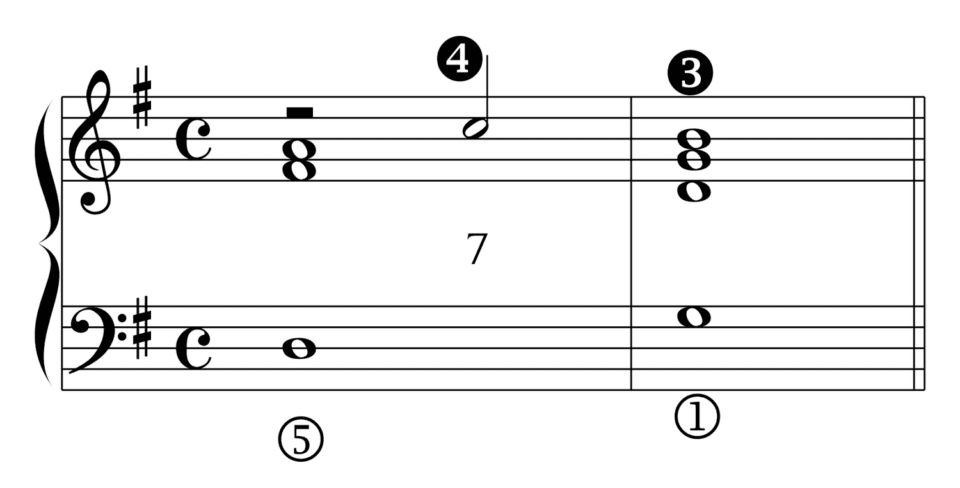Paragrafo introduttivo
What is an Axiom?
In Mathematics, an Axiom is a statement or proposition on which an abstractly defined structure is based.
Mathematics is perhaps the most perfect science because it is the most abstract.
And how can something valid for Mathematics be equally valid for Music?
Well, perhaps it’s more correct to think of these axioms not so much for what they are in themselves but for what they are used for.
Cause-Effect: For example, starting from what you play:
“If you do this, then the consequence will be that,” “if you play this note, you will go in that direction.”
Effect-Cause: Or starting from the final result:
“If you want to go to that key or to that degree of the scale, then you can do this, and you will certainly get there.”
I find that the usefulness of these Axioms, for a Musicus Practicus, is to have ready in the hand, in the mind, and in the ears, a strategy to move and strike in one direction rather than another.
Let’s now discover Fenaroli’s axioms!
And then a video in which we will listen to them all!

If you are a true enthusiast of Early Music, Historical Composition, Renaissance and Baroque, and you would like to have many more contents and always learn more, I warmly invite you to subscribe to the Patreon platform!
With your constant monetary support, of any amount according to your possibilities, you have the right and access to exclusive resources every week to keep learning!
Except when my iPad pencil breaks, of course; in that case, it takes a few days for the new one to arrive XD.
The secret that the Musicus Practicus has to become excellent in what he does is precisely this: learn every day, even a little, but every single day!

Axiom 1: Minor 7th on the 5th degree

The First Axiom is clear and simple:
- Cause-Effect: If you are on the fifth degree of the scale and add the minor seventh, which is the fourth degree of the scale, then you will move towards an 8/5/3 chord on the first degree.
- Effect-Cause: If you want to go to the first degree with an 8/5/3 chord, then first go to the fifth degree and add a minor seventh.
Axiom 2: Diminished 5th on the 7th degree

The First Axiom is clear and simple:
- Cause-Effect: If you are on the fifth degree of the scale and add the minor seventh, which is the fourth degree of the scale, then you will move towards an 8/5/3 chord on the first degree.
- Effect-Cause: If you want to go to the first degree with an 8/5/3 chord, then first go to the fifth degree and add a minor seventh.
As you can see, the first and second axioms are very similar, and from the point of view of (dis)functional harmony, they are the same thing.
But we are Musici Prattici; we go beyond the twentieth-century vision full of cognitive distortions still widely taught in the vast majority of Academies and Music Schools around the world!
We, Musici Prattici, go beyond!
We read the notes as the ancient masters did, remaining firm, faithful, and well-founded on the ancient and authentic way of reading music!
So, in Axiom 1, the bass sings DUt – GFa.
While in Axiom 2, the bass sings F♯Mi – GFa.
A totally different world!
This way of reading music, used by the ancient Masters, is called Hexachordal Solmization, and you can learn it in the Solmisation Course of the Renaissance Musicus Practicus Path.
Click on the image to discover the magic that awaits you!
Axiom 3: Augmented 6th on the 6th degree

The Third Axiom is quite contrasting from the first two:
- Cause-Effect: If you are on the sixth degree of the minor scale and add the augmented sixth, which is the fourth degree of the scale, then you will move towards an 8/5/3 chord on the fifth degree with a major third.
- Effect-Cause: If you want to go to the fifth degree with an 8/5/3 chord having the major third, then first go to the sixth degree and add an augmented sixth.
By the way, in this third axiom, the bass sings Fa La, the Fa above La of the Hexachord built on Fut: Fut-Gre-Ami-Bfa-Csol-Dla-Efa.
Axiom 4: Augmented 4th on the 1st degree

The Fourth Axiom returns very close to the first two:
- Cause-Effect: If you are on the first degree of the minor scale and add the augmented fourth, which is the fourth degree of the scale, then you will move towards a 6/3 chord on the seventh degree.
- Effect-Cause: If you want to go to the seventh degree with a 6/3 chord, then first go to the first degree and add an augmented fourth.
As you can see from the image, taken from the modern edition available for free on the website partimenti.org (click on the image), this is valid even if the note Gsolreut is the fourth degree of the key of D major.
The reason is very simple: the key of G major and that of D major share a common hexachord, the one on Dut: Dut-Are-F♯mi-Gfa-Asol-Bmi.
This makes it possible to use the same passage in both keys.
What helps us then to distinguish whether we are in G major or D major?
Well, obviously the context of what happens before and what happens after.
In the video you find below, you can learn that in more detail:

The First Axiom is clear and simple:
- Cause-Effect: If you are on the fifth degree of the scale and add the minor seventh, which is the fourth degree of the scale, then you will move towards an 8/5/3 chord on the first degree.
- Effect-Cause: If you want to go to the first degree with an 8/5/3 chord, then first go to the fifth degree and add a minor seventh.







